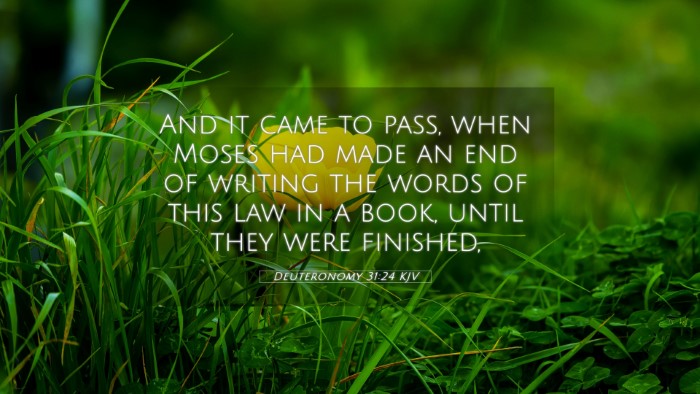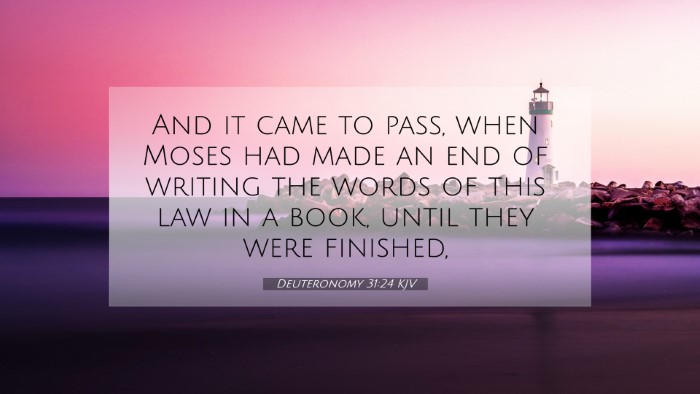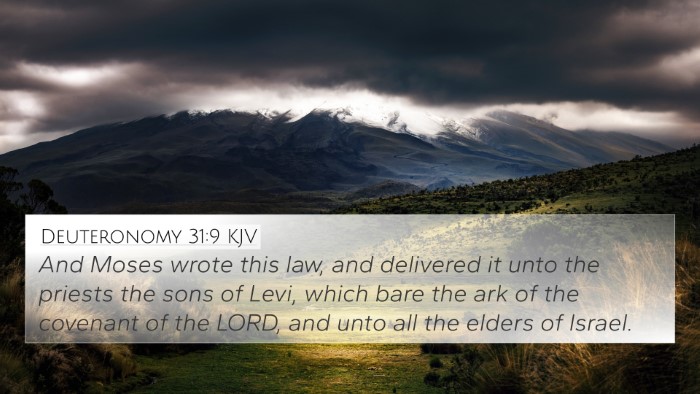Understanding Deuteronomy 31:24
Bible Verse: Deuteronomy 31:24 - "And it came to pass, when Moses had made an end of writing the words of this law in a book, until they were finished,"
Overview
This verse marks a pivotal moment in the narrative of the Israelites, as Moses completes the writing of the law that will govern them. The act of writing signifies the importance of the law in the community and serves as a foundation for their governance and identity.
Commentary Insights
-
Matthew Henry: Henry emphasizes the significance of Moses as the lawgiver and the gravity of his task in writing the Law. He suggests that this act demonstrates the seriousness of Israel's covenant with God. It is both a historical event and a spiritual act where the Law is to be regarded as a definitive guide for the people of Israel.
-
Albert Barnes: Barnes notes that the completion of the writing signifies a closure, making room for the new generation to embrace the laws meant to guide them in the Promised Land. He points out that this was not merely a bureaucratic process but an essential spiritual milestone for the Israelites, which establishes their identity and relationship with God.
-
Adam Clarke: Clarke discusses the importance of the written word of God, asserting that the law was meant to be applied to the hearts of the people. He also reflects on the meticulous nature of the writing process, highlighting that it signifies a transfer of authority from Moses to the future leaders of Israel as they take on the responsibilities outlined in the Law.
Thematic Connections
Deuteronomy 31:24 connects richly with various themes in both the Old and New Testaments. The act of writing the law signifies communication between God and His people. Understanding this verse opens up numerous connections with other scriptures.
Cross-References
- Exodus 24:4: Moses writes down all the words of the Lord, emphasizing the foundational aspect of law writing.
- Joshua 1:8: The command to meditate on the law day and night suggests the ongoing importance of written law in Israel’s life.
- Psalm 119:105: "Your word is a lamp to my feet and a light to my path," indicating that the law provides guidance.
- 2 Timothy 3:16: All Scripture is inspired by God,
affirming the authority of written laws and teachings.
- Romans 10:4: Christ is the end of the law for righteousness to everyone who believes, relating the law to New Testament grace.
- Hebrews 8:10: God’s laws are to be placed in the minds and written on the hearts of His people, reflecting continuity in God’s approach to His covenant.
- Matthew 5:17-19: Jesus asserts that He did not come to abolish the law but to fulfill it, linking the Old and New Testament views on the law.
- Luke 24:44: Jesus speaks of the law of Moses, underscoring its lasting significance.
- Galatians 3:24: The law serves as a tutor to bring people to Christ, showcasing the transition from the written law to the living word.
- Acts 15:10: The early church grapples with the implications of the law, continuing the conversation of its relevance.
Conclusions
The writing of the law in Deuteronomy 31:24 is not merely an historical record; it initiates a fundamental shift in how the Israelites understand their relationship with God, their community, and their identity. The connections drawn from this verse elucidate not only the continuity of God’s covenant but also the evolving understanding of law throughout the Scriptures.
Using Cross-References for Deeper Understanding
For those wishing to engage deeper with this text, employing tools for Bible cross-referencing is invaluable. These tools allow one to explore the connections between different biblical texts, thereby enriching a reader's understanding. Here are some recommendations:
- Utilize a reliable Bible concordance for efficient reference.
- Engage with a Bible cross-reference guide to navigate thematic connections.
- Practice cross-reference Bible study for comprehensive insight.
- Learn how to use Bible cross-references to identify relationships between verses.
- Explore Bible reference resources to further your studies.




